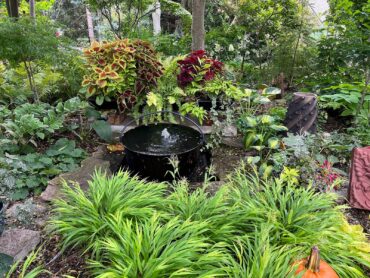
Those shady spots in the landscape can make it challenging to grow a beautiful garden. Fortunately, there are more plants than you may think that will thrive in low light.
Monitor the amount of sunlight the area receives throughout the day, season and year. You may be surprised that it gets more sunlight than you thought. Some plants, like spring ephemerals and even sun-loving spring-flowering bulbs, receive sufficient sunlight early in the season before most trees leaf out. Other plants need sunlight throughout the growing season and those sun-loving plants growing in hotter regions often benefit from a bit of afternoon sun.
Make a list of plants you have had success with and those that failed in the shady location. Use these to help you select or avoid plants with similar light requirements. For example, if peonies bloom and tomatoes produce fruit, this area receives quite a bit of sunlight, enough to grow most full-sun plants.
Consider mulching the soil when there is more shade than even shade-loving plants can tolerate. Add a table and chair for relaxing and a few steppers, if needed, to enjoy the cool shade.
When planting under or near trees, be careful not to damage them when creating your shade garden. Don’t bury, cut, dig or shave off surface roots, creating entryways for harmful insects and diseases. Skip adding soil over the roots as even an inch can kill some tree species.
Avoid deep cultivation that damages the fine feeder roots critical for water and nutrient absorption. Keep in mind that the majority of tree roots grow within the top 18 inches of soil, with 50% of these in the top 6 inches.
Instead, carefully dig relatively small planting holes between major roots, then mulch and spot water new plantings to minimize root damage. It may take transplants a little longer to fill in, but your tree will be healthier and live longer.
Add a splash of color with a few potted annuals set among the perennials. Or permanently sink a few pots in the ground and set potted flowering plants inside them. It’s easier on the tree roots and your back.
Check soil moisture several times a week and water thoroughly as needed. Plants growing under large trees or overhangs need more frequent watering, especially in the first two years until they become established. The dense canopy of many trees and impervious overhangs prevent rainfall from reaching the ground below. Plus, the extensive root systems of trees and shrubs absorb much of the rainfall that does make it through.
Avoid high-nitrogen, quick-release fertilizers that promote lush succulent growth that is more susceptible to insects and diseases. And with limited light as a potential plant stressor, this can increase the risk of problems. Use a low-nitrogen, slow-release fertilizer that promotes steady above- and below-ground growth.
Protect new plantings, especially hostas, impatiens, caladiums, coleus, turtleheads, wax begonias, Solomon seal and others often damaged by deer and rabbits. Apply animal repellents before the animals start browsing for better results. Select a rain and snow-resistant product, like organic Plantskydd, so you won’t need to reapply as often. Always check the product label and follow the directions for the best results.
You can create a beautiful shade garden for years of enjoyment with proper plant selection and care.
























